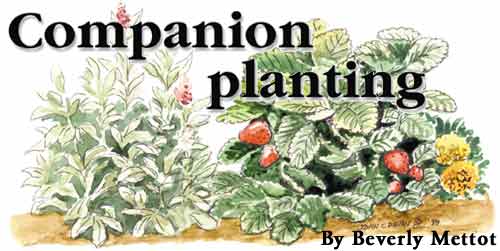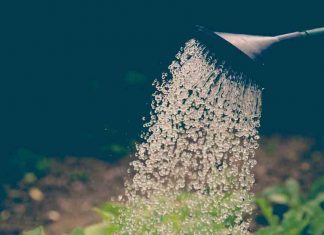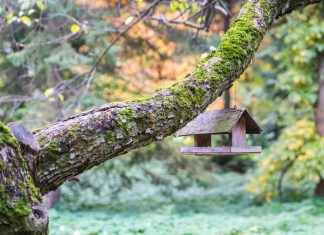| By Beverly Mettot | |
| Issue #81 • May/June, 2003 |
Companion planting is nothing new, and yet in recent years it has made an extraordinary comeback, not only in fooling those pesky pests who thrive on fruits and vegetables in the vast majority of home gardens, but also in providing healthier, tastier foods.
The welter of odors, colors, and textures of heavily interplanted plant companions can confuse, deter, and even stop pests altogether. But plant companion methods can also confuse the home gardener in deciding which plants go where, with which other plants, and for what reason. Equally confusing are the ideal planting crops: why certain plants belong while others don’t, which plants fool even the most persistent of pests, and which ones are better left out of the garden.
There are virtually hundreds of examples of plant companions recorded in garden lore, and modern research substantiates their effectiveness. For instance strawberries, cabbage, and tomatoes can be planted in and around sage to benefit one another in the garden. But plant cucumbers with that same sage and you’ll have a disaster on your hands.
While everyone loves the idea of seed turning to vegetable, things can (and do) go wrong during the growing season, namely pests. As Jack Kramer pointed out in The Natural Way To Pest-Free Gardening, “Insects are a highly trained, well-ordered society. So well ordered they can quickly destroy valuable plants in the garden.”
That’s where companion planting comes in. By intermixing certain aromatic herbs, or pungent French marigolds, or any number of beneficial plants and flowers, the home gardener finds a natural deterrent which helps repel insects and better protects his crop.
The need for companion plants
I began experimenting with this method four years ago when I encountered my first tomato hornworm, and I’ll be the first to attest that the combination of sweet basil and French marigolds really do keep these pesky little (or not so little) caterpillars at bay.
Much of today’s companion planting is based on the combination of both fact and folklore, but scientists have enough evidence to convince them of the following:
- Plants with strong odors do confuse, deter, and oftentimes stop certain pests.
- Certain plants hide other certain plants we don’t want detected.
- Certain plants, and especially herbs, are considered nursery plants for the good insects providing shelter, nectar, pollen, and even dark, cool moist spots for lacewings, lady beetles, parasitic flies, and wasps.
- Certain plants serve as a “trap” crop, which pushes insects away from other essential plants (rue’s bad odor and disagreeable taste will keep even the most persistent of pests away).
- Certain plants create habitats which attract more beneficial insects (such as lady beetles, praying mantis, and ambush bugs).
Ideal planting crops are plants whose odors ward off unwanted insects. French marigolds are the best example. Not only does its strong odor literally confuse pests looking for their favorite plants, but their roots give off a substance which repels nematodes. The more you have planted in the garden, the better its effectiveness.
Among the most popular of repellent plants are garlic and chives because of their powerful ability to repel aphids and beetles. Similarly, savory, chamomile, and thyme are ideal planting crops. These three herbs will attract more beneficial insects than any bright, pretty flower will. So when you’re planning your summer garden, include plenty of each.
Virtually all herbs benefit the garden in some way, whether to attract good insects, enhance the flavor of nearby plants, or to confuse those insects we simply don’t want around.
Certain flowers also attract beneficial insects: asters, zinnia, and sunflowers all work together to keep the good company coming to our yards. When I put in our sidewalk, I wanted plenty of flowers to line it. Many of the plants I included led me to my first encounters with lacewings and ambush bugs. Thank goodness I looked them up before plucking them off.
The don’ts
Sometimes, the toxins of one plant totally destroy the health or growth of certain other plants. A Black Walnut tree, planted within 60 feet of your garden, can inhibit the growth and/or development of vegetables, azaleas, rhododendrons, blackberries, lilacs, peonies, and apple trees. It gives off a toxin called juglone which can do some serious damage to other plants. This chemical reaction is known as allelopathy. Sunflowers also have allelopathic properties.
If you see a plant failing, but can’t see any visible reason why, it might be its neighbor. (See “The don’ts of companion planting.”)
| The Interplanting of Vegetables | ||
| The following table should act as a guide to help you eliminate certain problems in your garden. | ||
| Anise | Coriander | Aids the growth and flavor of Anise. |
| Asparagus | Parsley or basil | Controls Aspargus beetles. |
| Basil, Sweet | throughout garden | Enhances the flavor and growth of everything around it. |
| Carrots | Sage | Deters carrot (rust) flies. |
| Chamomile | throughout garden | Brings overall health to the garden. Attracts good insects. |
| Chervil | Radishes | One plant requires heavy nutrients while the other requires very little. |
| Chives | Carrots, grapes, roses, and tomatoes | Curb Japanese Beetles, and black spot. |
| Corn | Snap beans or soybeans | Enhances growth of corn. |
| Cosmos | throughout garden | Bad insects won’t come near it, but it will attract pollinating wasps. |
| French Marigolds | throughout garden | Strong odor confuses pests looking for their favorite plant. |
| Garlic | throughout garden | Repels aphids and beetles. |
| Mustard | Beans | One plant requires heavy nutrients while the other requires very little. |
| Mints | Cabbage, strawberries | Deters aphids and other aphid pests, as well as ants who invade strawberries. |
| Nasturtiums | throughout garden | Repels aphids and white flies. |
| Onions | Carrots | The two combined help to control rust flies and some nematodes. |
| Peanuts | Corn | Increases yields of both crops. |
| Peas | Lettuce, spinach, and Chinese cabbage | Benefit from the shade and wind protection peas provide. |
| Potatoes | Horseradish and/or tansy | Plant plenty for maximum benefits in attempt to ward off Colorado Potato Beetles. |
| Radishes | Squash, cucumbers, and/or Carrots | Great deterrent against Cucumber Beetles and Rust flies. Also eliminates diseases spread by these plants. |
| Rue | throughout garden | Disagreeable taste and bad odor sends even persistent pests on their way. |
| Sage | Strawberries, Cabbage, and/or Tomatoes | Deters unwanted pests and benefits each other in garden. |
| Savory | throughout garden | Ideal planting crop. Attracts good insects. |
| Spinach | Beans or tomatoes | Benefits from the shade both plants provide. |
| Strawberries | Borage or sage | Enhances flavor of fruit and strengthens plant’s resistance to insects and diseases. |
| Tansy | Cabbage and/or potatoes | Deters Cutworms, Cabbage Worms, and Colorado Potato Beetles. |
| Thyme | Tomatoes and/or cabbage | All three together control Flea Beetles, Cabbage Maggot, White Cabbage Butterflies, Colorado Potato Beetles, and imported Cabbage Worms. |
| The Don’ts Of Companion Planting |
| Don’t plant French marigolds with beans. |
| Don’t plant tansy with collards. |
| Don’t plant cucumbers with sage. |
| Don’t plant chrysanthemums with lettuce. |
| Don’t plant wormwood with peas or beans (wormwood in other areas of the garden will deter slugs.) |
| Don’t plant peppers with tomatoes, potatoes, eggplant, or where peppers were planted in the last three years. |
| Don’t plant tomatoes with fennel or potatoes. |
| Don’t plant families that are closely related, and attract the same pests. |
| Don’t plant allelopathic plants too close to your garden. |















Why do you not plant peppers around tomatoes or eggplant?